Arrive in Colombo, where you'll meet your guide & transfer to your hotel in Negombo, a typical fishing village located not far from the Airport. Check-in your hotel facing the ocean and afternoon at leisure to recoup from the flight.
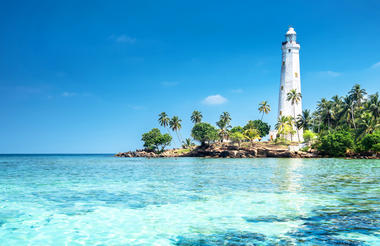
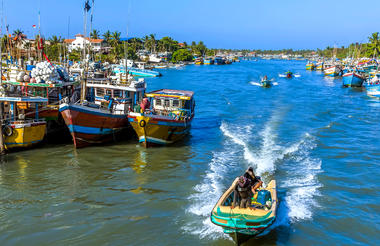
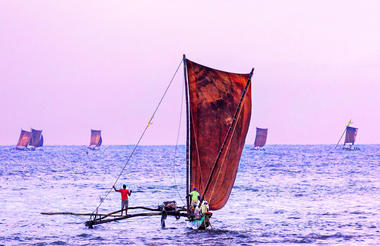
We leisurely check out of the hotel and depart to Meetiyagoda to visit the famous moonstone mine. A moonstone is grey in colour and feels cool and smooth to the touch. When polished it has a glow like of the moon. Have you ever wondered where that pretty little moonstone on your finger actually comes from? Moonstones are in the semi-precious category and are an important component of the Sri Lankan gem industry.
Continue on to Galle where you'll embark on an afternoon sightseeing tour.Tonight’s dinner is at a local house.



Moonstone has been mined in these sweltering forests forever and the moonstone mines, little more than muddy rabbit holes, 6m or 7m long, are fascinating as is the process of filtering out the precious stones, cutting them up and polishing them up ready for sale. At the Moonstone Factory, you can see or even go down into a narrow shaft where the stones are mined.
The miners climb down a 10-metre-deep shaft on a frame made of strong coconut wood. A machine pumps out water, but all the digging is done by hand. The buckets of soil that are wound regularly to the surface yield around 50-100 rough moonstones a day, though not all of them are saleable quality. It is believed by the villagers that this piece of land, around an acre in extent, is blessed by the moon.
The ancient trading post of Galle is said to be the famous Tarshish of the Bible. Historically, this award-winning World Heritage fortified township was an essential port of call for Chinese, Persian, Arab and Indian traders. Javanese and Sumatrans came later followed by Marco Polo in 1299 AD. The Portuguese arrived in the 1500’s and built a settlement with a fort of palm trees and mud. This was captured by the Dutch (and finally the British) who built the 400 year old fort with great ramparts and bastions to protect their presence. Narrow streets are lined with old houses displaying Dutch heritage, with their pillared verandahs. Government offices remain in use and the community within the fort is a bustle with daily life – a living-breathing town, hidden within fortified walls of this ancient, maritime citadel.
Laughter, chatter, gossip and smiles abound within the rampart walls. We explore the fort, overflowing with landmarks, strolling past the Dutch church, the governor’s house, the spice warehouses, court square, the Kacheri or Town Hall, the lighthouse and ramparts. Near the old Arab mosque are streets leading to cricket fields and the district Judge’s house, surrounded by ancient frangipani trees. There’s a variety of exclusive boutique stores to explore.
After breakfast, we enjoy a bicycle tour along Sri Lanka’s countryside roads, passing paddy fields and settlements that offer a glimpse into rural lifestyles. Our ride ends at Kahanda Kanda, a tropical paradise built as a private villa, where we have a traditional ‘Southern’ lunch.
The bicycle ride is about 15 kms long, for those who do not want to cycle a tuk-tuk can be arranged to take you on the same path.
The rest of the day is at leisure to revisit the Galle Fort or the following visits.Return to the hotel and spend the rest of the day at leisure



Martin Wikramasinghe Museum
Visit the nearby village of Koggala, the home of Sri Lanka’s most famous author, Martin Wikramasinghe, now a Museum of Folk Culture and local lifestyle, surrounded by eight acres of a restored eco-system with hundreds of varieties of indigenous trees and shrubs in which bird life abounds. There’s a special collection of artifacts and memorabilia offering insight into a world of tradition, integrated and at peace with the environment.
Handunugoda Estate
An estate growing spices and producing the award winning and globally acclaimed Virgin White tea, untouched by hand and deemed the purest of all. The 140 year old eco-friendly estate is rich in flora and fauna. Birds and wildlife, myriad colored reservoirs and fish ponds give it a special atmosphere. Meet with experts here, who takes you around this organic plantation of Cinnamon, Cardamom, Cloves, Turmeric, Vanilla, Rubber, Coconut and other Spices.
Bicycle Tour along Sri Lanka's countryside.
After breakfast, checkout from the hotel and we drive to Nuwara Eliya.
Check inattentive the hotel and time for sightseeing at the renowned hill station of Nuwara Eliya,
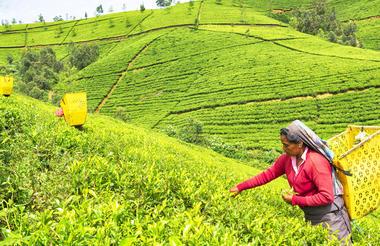
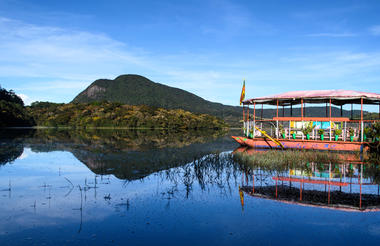
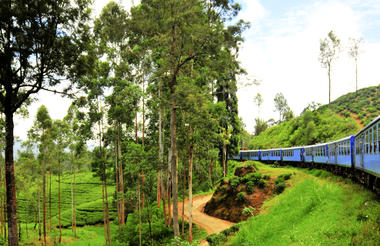
Nuwara Eliya is a mountain station at 1,868 m (6,128 ft) of altitude, in a splendid landscape. The city is particularly well-kept and neat, and the always green grass gives to the locality an aspect of “colonial British style". Nuwara Eliya was built entirely during the 19th century and its architecture mimics that of an English country town, with red-brick walls, country house like hill club and mock-Tudor half-timbering. Blessed with salubrious climate, breathtaking views of valleys, meadows, mountains and greenery; it's hard to imagine that Nuwara Eliya is only 180 Km from the hot and humid Colombo. Temperatures are 14C-21C (Jan- April) 16C-18C (May-Aug) 15C- 18C (Sept-Dec).
We leave for sightseeing at the renowned hill station of Nuwara Eliya, a retreat for British Civil Servants from the heat of the plains. Also known as Little England, Nuwara Eliya is famous for its spectacularly beautiful approach, picturesque landscape and cool climate. Many of its buildings retain features from the colonial period along with a 117-year-old championship golf course, one of the most scenic in the world, nestled between the town and surrounding forested hills.
Transfer from Galle to Nuwara Eliya
Travel to Horton Plains, Sri Lanka's highest plateau, 7200 ft above sea level in the central mountain country. This ‘Fen” is a very scenic region with an astounding variety of scenery from mountains to grasslands, from marshes to trout streams. Sri Lanka's best flavored high grown teas are grown in the surrounding areas. Spectacular view from 'Worlds End' where the plateau plunges a thousand feet in a straight sheer drop.
Rest of the day at leisure to explore Nuwara Eliya.



After breakfast, check out from the hotel and take a tour to a Tea plantation / Factory to gain insight into the local tea manufacturing process including the daily routing of local workers/ Tea pluckers.Visit the Tea Factory and witness how the raw green leaf which was plucked is converted to the familiar dark brown product through a process of drying, cutting, rolling and fermentation. At the factory, also learn to “taste” tea and try to identify the subtle differences in flavor produced at the factory.
Depart for Nanu Oya Station and board the train leaving for Peradeniya
We continue journey to the highlands of Sri Lanka. You will proceed to Peradeniya by train, Your luggage will travel by car / Van. You will then be picked up from the Peradeniya train station and transferred to the hotel.Evening at leisure.
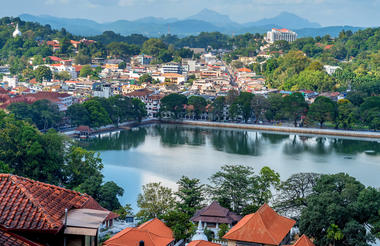
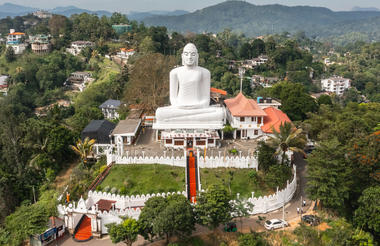
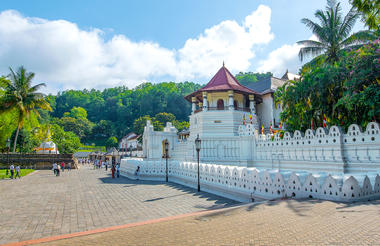
Sri Lanka is one of the world's largest exporters of tea. Since the introduction of tea to Sri Lanka in mid 19th century, Pussellawa has been in the mids of the tea industry. For many miles prior to reaching Pussellawa Town from either direction you will find acres and acres of tea plantations, in fact, nothing but tea estates. There are many factories open for visitors which also have tea sales outlets.
Kandy was the last bastion of Buddhist political power against colonial invasion. This hill station is remarkable for the natural beauty of its setting in a peaceful wooded valley overlooking a vast artificial lake. The palace, shrines and British period buildings give it a special character, while the Buddha’s tooth relic lends a religious importance to the historic highland capital.
This morning we explore Kandy on a brief panoramic tour via the upper lake drive, stopping at the market square, including a visit to the Royal Botanical Gardens & The Temple of Tooth Relic.
After lunch, it is free time for shopping.



TEMPLE OF THE TOOTH RELIC - The famous Dalada Maligawa or the Temple of the sacred Tooth Relic. Kandy is the most venerated place of worship for Buddhists throughout the world. Built in the 16th century, this temple houses the sacred Tooth Relic of the Buddha brought to Sri Lanka from the Kalinga province in ancient India in the 4th century AD. Several buildings have been added to the temple complex by successive rulers, the latest being the Golden Canopy over the inner shrine where the Tooth Relic is placed. Originally the Temple was within the King's palace complex as it was the symbol of Royal Authority.
Traditional Kandyan dance includes the cobra dance, mask dance and the Ginisila (showing power over fire). The entire chaotic and colorful spectacle climaxes with an amazing fire-walking act. The dancers wear elaborate costumes, including a headdress, and their chests only covered by a decorative beaded net. The Kandyan dance is traditionally performed to percussion only; the most common drums are the ‘Geta Beraya’ and ‘Yak Beraya’. To assist the dancer to keep rhythm, a small pair of cymbals is used as well as a conch shell…… to announce the arrival of the dancers.
THE ROYAL BOTANICAL GARDENS, formerly the pleasure gardens of Kandyan kings is very impressive as is the 18 hole Victoria golf course, voted the most attractive in the subcontinent and amongst the hundred most beautiful anywhere. A round of golf can be arranged on this splendid undulating terrain, over which the holes are routed, combined with the backdrop of hills and lakes
After lunch - Free time for shopping
Leisurely checkout this morning, transferring to Dambulla, with an optional stop en route to visit a Spice plantation where clients will see the luscious Cinnamons, Cardamoms, Pepper plants etc. They can also purchase their requirement of spices. Clients will have the opportunity to learn of different spices and its significance to the local cuisine as Sri Lanka is famous for its rice and curries prepared using several spices
Visit Dambulla Rock Cave Temple



Like Sigiriya, Dambulla is a vast isolated rock mass and it was here that king Valagam Bahu took refuge from invasions in the 1st century B.C., later turning the caves into a rock temple. Some of its frescoes are over 2000 years old. Another highlight is a colossal figure of the recumbent Buddha carved out of the living rock, some 15 meters long. The caves have a mixture of religious and secular paintings and sculptures with ceiling frescoes depicting scenes from the Buddha’s life and Sinhalese history.
We spend today morning at leisure enjoying the calm surrounds of the Cinnamon Lodge.After lunch we take a 30 minute drive to Minneriya/ Kaudulla National park where we take a jeep safari in the Minneriya National Park which is home to large herds of wild Asian Elephants.



Minneriya has been a sanctuary since 1938 and features King Mahasena’s magnificent water reservoir from the 4th century, covering 3000 hectares. This important wetland supports paddy fields and many aquatic birds such as painted stork’s and spot billed pelicans.
The Kaudulla National Park, on the edge of the vast Kaudulla Biosphere Reserve and home to large herds of wild Sri Lankan elephants. This important wetland supports paddy fields and many aquatic birds such as painted stocks and spot billed pelicans.
Drive to see World Heritage Sigiriya.
Return to the hotel
This evening at about 1600hrs we leave our hotel for Dambulla for our very own ‘elephant experience’ organized especially for you.
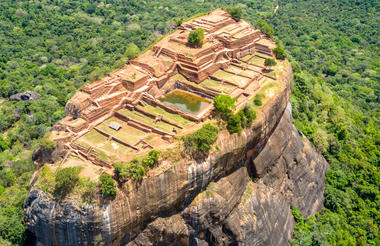
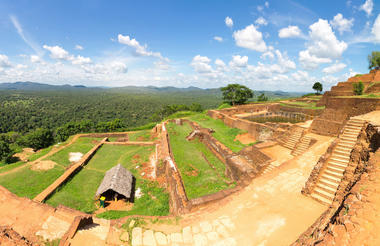
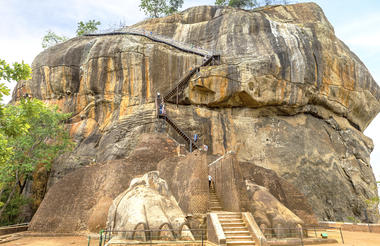
The giant rock fortress of Sigiriya was originally a hermitage for Buddhist monks until it became a bastion and palace in the sky for scorned royal son, King Kashyapa who initially took refuge there. In addition to its impregnable character, Sigiriya became a spectacular royal city with geometrically laid water gardens, fountains and serpentine walkways. While walking up we see 1500 year old frescoes of beautiful maidens, the mirror wall and ancient graffiti. The lion platform and summit of 1.6 hectares was surrounded by buildings during Sigiriya’s glory. It’s around 1200 steps to the summit yielding a spectacular panorama of surrounding jungle and Sigiriya village.
We have the opportunity to assist the mahouts in bathing the elephants by the lake feeding them fruits and countless picture opportunities!
To get to the location, groups will need to walk around 200 meters at a designated point in Dambulla , take a 10 minutes country boat ride to the place of the Elephants & on the return journey we will take a simple tractor ( land master ) ride back to the main road.
After breakfast, we take a pleasant drive of about an hour’s time to the medieval city of Polonnaruwa, another Unesco World Heritage site, which rose to fame as a capital between the 10th to 12th century AD. A resemblance to Angkor Wat, the Royal Palace and Audience hall, the Quadrangle and the spectacular Gal Vihare complex give evidence of Sri Lanka’s past glory.
Following our tour of the archaeological site, you visit a rice mill to learn how the paddy is processed, cleaned, packed, and transported to different parts of the country.
After lunch, we return to your hotel and spend the evening at leisure.
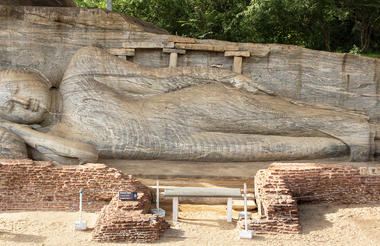


Visit the Anuradhapura, Archeological site - the 01st capital of ancient Sri Lanka.
We will visit the Kuttam Pokuna , Samadi Buddha statue , Moonstone & Abegiriya .
We check in at the charming Ulagalla Resort in time for a late lunch and the evening is spent enjoying the luxuries of the resort.



ANURADHAPURA - a UNESCO World Heritage Site located in the north central part of the Island was the first capital (5th century BC - 9th century AD), the centre of the island's Buddhist civilization and undoubtedly the grandest city of ancient Sri Lanka. In antiquity and the interest, it is the equal of any ancient 'buried city' in the world. The oldest historically documented tree on earth (over 2,200 years old) - The Sri Maha Bodhi, brought as a sapling of the tree under which the Buddha attained enlightenment, and the island's oldest Buddhist shrines - some dating back to the 3rd century BC, impressive white 'dagabas' (relic chambers) and monuments embellished with handsome stone carvings or sculpture, pleasure gardens, beautifully executed stone baths and ponds and a superb irrigation system of reservoirs and canals are the main attractions of Anuradhapura.
Once a chieftain’s mansion, Ulagalla features a 150-year-old mansion at its centre, with 20 private, ecologically-built villas spread across 58 acres of lush greenery. With its own solar farm generating half of its own energy requirements, Ulagalla is truly a unique boutique hotel in Anuradhapura. Enjoy the ambience of ancient kingdoms or nature-based adventures whilst immersed in luxurious, ecologically-sustainable beauty. The lush environment, stunning landscaping, and exquisite attention to comfort, makes for an unforgettable experience amidst a green oasis. Ulagalla is also just a 30mins drive away from Anuradhapura.
Today with a packed breakfast and a picnic lunch we set off into Wilpattu National Park, where we go on an adventurous full day game drive into the park, on a 4 x 4.



Wilpattu is Sri Lanka’s largest national park with an area of 130,000 hectares. It is also the oldest national park which has been reopened after several years of closure due to the armed conflict in the country. A few decades ago it was Wilpattu that was known ahead of Yala for its Leopard population. A unique feature of Wilpattu national park is that the entire park is dotted with large sand rimmed natural lakes known as “Villus”. The Villus collects rain water and tends to attract wildlife especially during the times of drought.
The main draw in Wilpattu is the leopard and sloth bear. It is also one of the better parks to see barking deer. Wilpattu is bounded to the north and south by 2 main rivers, the Modara Gamaru towards the north of the park and the Kala Oya to the south of the park.
Wilpattu is not only famous for its wildlife but also for its archaeological and historical importance. About 500 years before the birth of Christ it is believed that Prince Vijaya from India and his followers landed in a place called Thambapanni in the North West corner of Wilpattu and formed the Sinhalese kingdom. There are still many archaeological ruins and stories to be told about this and many other fascinating historical events that took place within the borders of what we now call Wilpattu.
We check out from hotel & we leave for Colombo.
Rest of the day at leisure.
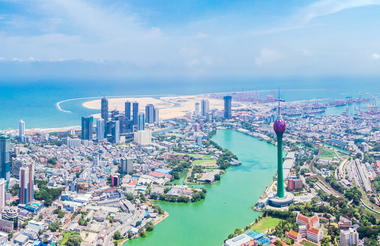
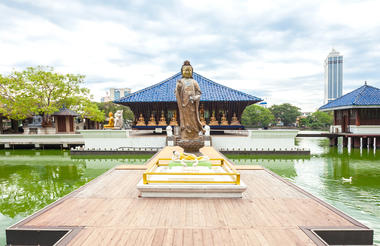
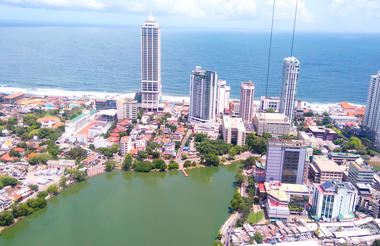
A leisurely morning at the hotel prior to checking out.
We drive around the capital and its impressive Parliament House, designed by celebrated architect Geoffrey Bawa. Colombo is fascinating, with a cosy mixture of past and present and is the commercial centre of the country.
We stop for lunch at Old Dutch Hospital, which has been impressively restored and now holds eateries, bars, boutique stores and spas. Constructed all of four centuries ago, the building is a resounding example of eastern Dutch architecture with high ceilings, thick walls, large wide windows and terracotta tiled floors.
After lunch, we visit the Colombo Fort area & witness the Colonial heritage, parts of this tour is done by foot.
Thereafter you will be transferred to the Airport in time to connect with your departure flight.

The original trading settlers - the Portuguese, Dutch and British have all left in their wake churches and monuments, names and religions, costumes and food and smatterings of their languages, which have been absorbed into the speech of Sri Lankans.




